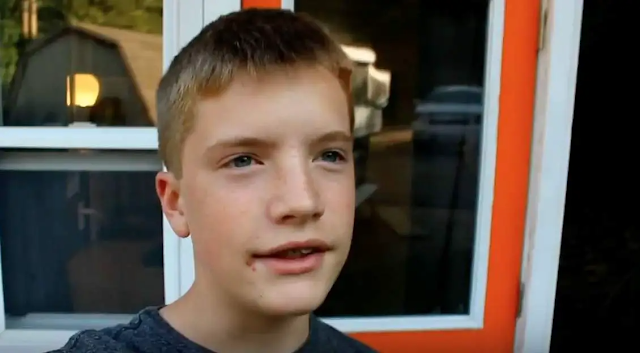At just 13 years old, Luke Thill from Iowa stands out from his peers—not because of his love for video games or gadgets, but because he built his very own tiny house. Unlike most kids his age, Luke turned his boredom into an ambitious project: a fully functional, 89-square-foot house in his parents’ backyard.
A Dream Built on Determination
Luke’s dream of building a house began with a simple desire to do something meaningful. His project, which cost about $1,500, took a year of hard work to complete.

To fund it, Luke mowed lawns, organized online fundraisers, took on odd jobs, and even bartered for services. For instance, a family friend helped him install electrical wiring in exchange for Luke clearing out his garage.

Luke also incorporated sustainability into his project. About 75% of the materials he used were recycled, including items from his grandmother’s house and a front door gifted by his uncle’s friend.
A Minimalist Sanctuary

The tiny house, measuring just 10 feet long and 5.5 feet wide, has electricity but no plumbing yet. Inside, it’s a cozy retreat complete with a loft bed, a microwave, a TV, and even a barbecue setup outside. It’s a space where Luke can unwind, do his homework, and occasionally spend the night.
“I liked the minimalism,” Luke explained. “And I wanted to have a house without a huge mortgage.”

Lessons in Responsibility
Luke’s parents were supportive of his venture but ensured he took ownership of the project. His father, Greg, made sure Luke covered most of the expenses himself.
“It was a chance for a kid to do something more than play video games or sports,” Greg said. “It teaches life lessons.”

Inspiring a Generation
Luke’s story has captured the attention of many, especially through his YouTube channel, where he shares videos documenting his journey. He hopes to inspire other kids to take on big projects and realize their potential.
“I want to show kids it’s possible to build at this age,” Luke said.
Have a look at this project below:
Looking ahead, Luke dreams of building a slightly larger house when he’s older—perhaps one he can use during college.
A Young Visionary
Luke Thill’s tiny house is more than just a personal achievement; it’s a testament to hard work, resourcefulness, and the power of dreaming big. His story is an inspiring example of what young people can accomplish with determination and a little support from their family.
If you’re inspired by Luke’s incredible project, share his story to encourage others to think big and act boldly!
If You Ever Shop At Dollar Tree, Make Sure These Items Are Never In Your Cart

Dollar Tree is a tempting place for deals, but experts caution against buying ten items there. Electronics like headphones and chargers have a short lifespan. Spray bottles and cleaning supply nozzles tend to break quickly. Utensils, batteries, and crayons are also of low quality. Plastic kitchen tools might be useful for one-time use but not for durability. Canned goods aren’t always cheaper at Dollar Tree. Hair and skin care products lack quality ingredients. Gum packaging can be deceiving, with smaller portions than they appear. To avoid disappointment, focus on quality items at other stores for electronics, utensils, batteries, crayons, kitchen tools, canned food, beauty products, and gum.



Leave a Reply